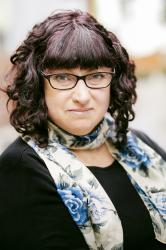MTC: Faith Healer
Faith Healer, directed by Judy Davis, at Sydney’s Belvoir last year was so successful that the MTC put it into the Sumner Theatre. While twice as many can see it each night, most can’t experience the intimacy that made it so successful and the production struggles to find its strength in the large space.

Irish playwright Brian Friel’s play of four monologues only lasted for 20 performances on Broadway (with James Mason) in 1979 but has since gone on to scoff at those first reviews and opinions.
In the 1950s, Irish faith healer Francis “The Fantastic” Hardy (Colin Friels) travelled through Wales, Scotland and Ireland with his wife, maybe mistress, Grace (Alison Whyte), and manager-cum-dogsbody Teddy (Paul Blackwell). As their monologues coincide in time, the audience can imagine them together and find their own truths, which sit somewhere between comforting and devastating.
Moving from places including village halls, a desolate roadside, and a pub that’s more of a lounge bar, they remember more about death than healing. And their memories are shaped by the conscious and unconscious tweaks that create a story that can settle in their own psyches, no matter how broken or blackened, and help them make the only choices that feel right for them.
Friels holds his emotion tightly with a heavy physicality that makes Francis feel every movement as pain. Whyte leads with Grace’s heart and shares the emotion that lets us into her thoughts. Blackwell’s Teddy connects with the audience as he also sees the couple from an outsider’s perspective and because he survives by finding the awkward humour that offers much-needed space to breath and reflect.
But while they talk to us, we don’t know who “we” are. We’re not Francis’s “fictions” or “despairing people” wanting to be healed or to give up on hope. Are they talking to judge, jury, friends, strangers or gods? Are we listening to a confession or a yarn?
This is questioned more as most of the audience have little direct connection the stage. Brian Thomson’s design of an empty town hall engulfed by storm clouds (that subtly change colour and mood with Verity Hampson’s lighting) is clearly made for Belvoir. So much that ther’s a Belvoir-shaped thrust staged and a couple dozen of the luckiest punters get to sit on the extra seats around this stage. But while most of the audience were so close in Belvoir, I felt too distanced in the closest third of the seating bank.
If post-show chat is anything to go by, those close and centre had a much more engaging evening, but it left me watching performances and listening to words rather than being so lost in the memories of the characters that their pain was felt.




